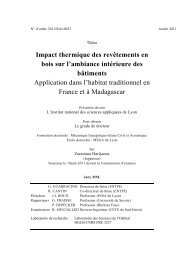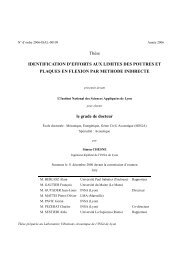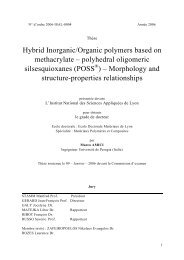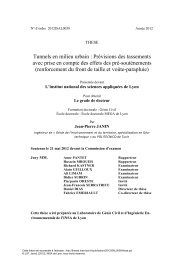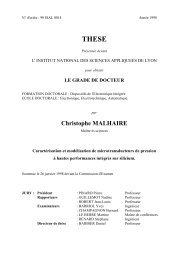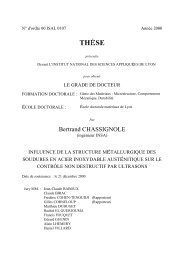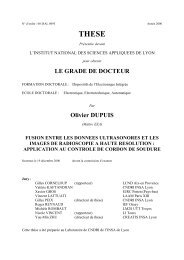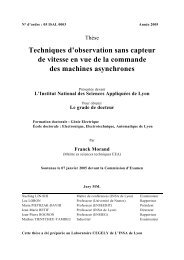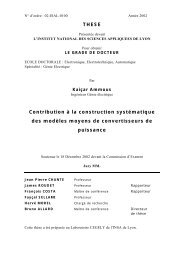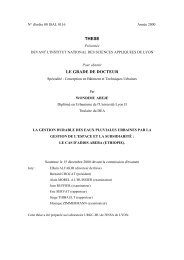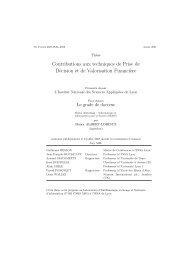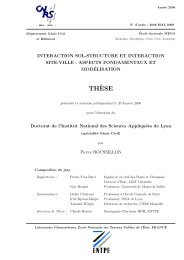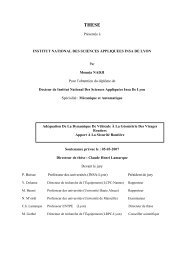Segmentation d'images couleur par un opérateur gradient vectoriel ...
Segmentation d'images couleur par un opérateur gradient vectoriel ...
Segmentation d'images couleur par un opérateur gradient vectoriel ...
You also want an ePaper? Increase the reach of your titles
YUMPU automatically turns print PDFs into web optimized ePapers that Google loves.
QUANTIFICATION ET MORPHOLOGIE DE PHASES DE CLINKER PAR ANALYSE D'IMAGE.<br />
The contrast of the phases depends on the pre<strong>par</strong>ation of the sample. To saturate the<br />
pores of the clinker, it has to be embedded with epoxy resin in a vacuum, and after hardening,<br />
the pre<strong>par</strong>ation is polished. To make the following etching as regular as possible, the surface<br />
should be scratch-free and without any relief. Different etching methods can be used for the<br />
visual microscopic examination. For the human visual system, coloration is only one of many<br />
<strong>par</strong>ameters in the crystal identification, but for image processing, a regular coloration is<br />
presupposed. Therefore, etching should fulfil the following requirements:<br />
• The coloration of the different phases must be as homogeneous as possible. The<br />
crystals of the same phase should be coloured equally. The colour should be<br />
homogeneous within a crystal.<br />
• The etching must be repeatable.<br />
• The etching should make the inner structure of the crystals visible (texture in the<br />
belite).<br />
The upper requirements are fulfilled with a combination of HNO3 and NH4Cl. This<br />
method is preferred to the etching via HF vapour, which is used in other studies [Märten et al.,<br />
1994 ; Theisen, 1997]. The first ones are easier to use and less dangerous. They colour alite blue,<br />
belite brown and emphases the laminar structure of the belite. Little variations in the hue of<br />
certain crystal and in the internal coloration of the crystal can be accepted. Image processing can<br />
be adapted to these tolerances. The proposed system is optimised to a clinker, which is pre<strong>par</strong>ed<br />
as described.<br />
2.3 IMAGING SYSTEM<br />
Automatic image processing is based on digital images. The transition from the<br />
microscope to the computer is made in two steps. Firstly, the microscopic image is changed in an<br />
electric signal by a video camera. Current CCD colour cameras (SONY DXC-C1MDP) produce<br />
images with high resolution. The video signal can be visualised with a TV-screen or it can be<br />
digitised by a PC-digitiser-board (MATROX Meteor frame grabber) which forms a digital image<br />
from the input signal. The colour information in the video signal is divided in the three<br />
components: red, green and blue (RGB). Each component is se<strong>par</strong>ately digitised, allowing the<br />
representation of the true colours of the clinker on the PC-screen.<br />
The well-focused image can be saved and the system is ready for the next image. The<br />
operator can store a great number of images for the same clinker sample in a very short time.<br />
These images are then processed on a standard PC that easily provides the possibility to store the<br />
colour images and print them out.<br />
2.4 IMAGE CHARACTERISTICS<br />
The digitiser divides the image in 768*576 picture elements (PAL-format). By using a<br />
magnification factor of the microscope as the point co<strong>un</strong>ting uses it, a resolution of<br />
WORLD CEMENT RESEARCH AND DEVELOPMENT 1998 97



